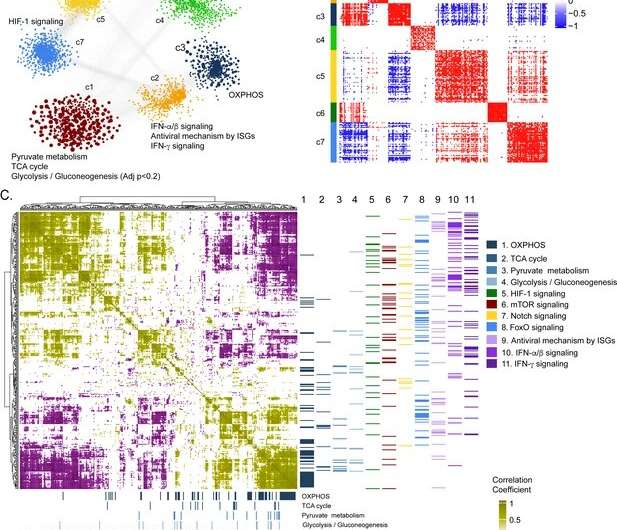Weighted co-expression network analysis. (A) Network visualization of seven gene co-expression communities identified. Nodes and node size represent genes and their centrality (degree) respectively and edges represent significant Spearman correlation (adj p < 0.001 and R > 84). Key significantly regulated pathways (adj. p < 0.05) in each community are labeled. (B) Heatmap of correlations among top 5% central genes in each community. Column and row annotation denotes corresponding communities. (C) Heatmap of significant correlation (adj. p < 0.05) between key metabolic and signaling pathways mentioned in (A). Column and row annotation denotes corresponding pathways. Credit: eLife (2022). DOI: 10.7554/eLife.76071
Researchers at Karolinska Institutet in Sweden have identified key signaling pathways that when blocked by existing drug candidates limit reproduction of the Crimean-Congo hemorrhagic fever (CCHF) virus. The findings, published in the journal eLife, offer hope for patients affected by this potentially deadly disease.
"The spread of the CCHF virus poses an increased threat to public health due to its high mortality rate in humans, which varies between 3 to as much as 40 percent in some regions," says the study's senior author Ali Mirazimi, adjunct professor at the Department of Laboratory Medicine, Karolinska Institutet. "Unfortunately, there are currently no vaccines or effective treatments available, which is why it is of utmost urgency to identify promising drug candidates that could lead to better treatments and reduce the high mortality rate."
The CCHF virus is primarily transmitted to people from tick bites or through contact with infected animals, although human-to-human transmission can also occur. The virus causes the disease Crimean-Congo hemorrhagic fever, which typically manifests itself with symptoms such as fever, muscle aches, joint pain, vomiting and bleeding, and can progress to organ failure and death.
The disease is endemic with fairly stable infection levels in 30 countries in Central Asia, the Middle East, southeast Europe and parts of Africa. However, with global warming, the ticks carrying the virus are spreading to other parts of the world, with more cases seen in other parts of Europe in recent years. The disease is classified as hazardous to society according to the Communicable Diseases Act.
Pathways identified
All viruses are parasites that are completely dependent on their hosts for reproduction. A virus that infects a cell reprograms the cell to create more virus. The cells' energy supply and functions are controlled via signaling pathways, and viruses take advantage of these pathways to spread within the body.
In the study, the research group investigated how the CCHF virus infects cells and what types of changes take place. Using blood samples from patients with both acute infection and one year after recovery and cell culture experiments, the researchers found that the CCHF virus prefers pathways involving energy metabolism to reproduce.
Drug candidates reduce viral spread
By blocking two key metabolic pathways, glycolysis and glutaminolysis, with previously identified drug candidates, the researchers were able to significantly reduce viral reproduction in a laboratory setting. The findings build on earlier research from the same research groups at Karolinska Institutet, including a study that found similar mechanisms involved in the proliferation of SARS-CoV-2, which causes the disease COVID-19.
"We hope that our findings can lead to new antiviral treatments against Crimean-Congo hemorrhagic fever," says the study's first author Ujjwal Neogi, researcher at the Department of Laboratory Medicine at Karolinska Institutet. "Based on our discovery, we will soon begin in vivo studies in animals and hopefully translate these findings into clinical trials in the near future."
More information: Ujjwal Neogi et al, Multi-omics insights into host-viral response and pathogenesis in Crimean-Congo hemorrhagic fever viruses for novel therapeutic target, eLife (2022). DOI: 10.7554/eLife.76071
Journal information: eLife
Provided by Karolinska Institutet





















